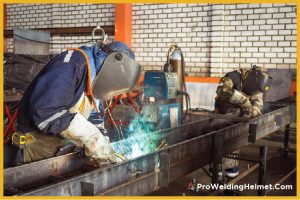Contents
History
Tig welding, also known as gas tungsten arc welding (GTAW), is a professional welding procedure that uses an electrode for the electric current to create a heat source to melt the metal.
It was first developed in 1941 and used with aluminium and magnesium. Although it was widely implemented in the 1950s, professional welders have used Tig welding as an essential part of their practice since its invention.
The process involves multiple intricate steps requiring professional knowledge, skill and precision; it is used across many industries, including aerospace in manufacturing and quality control inspections.
As such, Tig welding has become synonymous with professional quality artistry worldwide.
Tig welding has been an invaluable professional skill since its inception in the early 1930s. Invented by Russell Meredith, this form of welding joins two pieces of metal together by heating them with a non-consumable tungsten electrode and an inert gas mixture.
It is known for its excellent precision and easily adjustable heat settings, enabling professional welders to work on small intricate projects with great accuracy.
Tig welding techniques have slowly developed over time, allowing experienced welders to work on more vital metals with incredible speed and efficiency – significantly improving the production process.
Today experienced tig welders are highly sought after due to the remarkable versatility and control that this form of welding gives them in various industries such as aerospace, automobile manufacturing, and shipbuilding.

What Is Tig Welding
Tig welding, also known as gas tungsten arc welding (GTAW), is a professional welding procedure that uses an electrode for the electric current to create a heat source to melt the metal.
It involves several intricate steps and requires knowledge, skill and precision; it is used in manufacturing and quality control inspections across many industries, including aerospace.

The process involves a non-consumable tungsten electrode and an inert gas mixture to join two pieces of metal together, which can be further manipulated to desired shape and quality by the welder.
Tig welding is known for its excellent precision and easily adjustable heat settings, enabling professional welders to work on small intricate projects with great accuracy.
It is considered one of the most versatile welding processes available and has become an essential part of many industries worldwide.
How Does Tig Welding Work
Tig welding uses a non-consumable tungsten electrode and an inert gas mixture to combine two pieces of metal. The tungsten electrode is heated with an electric current, which creates heat and pressure that melts the metal together.
The welder then manipulates this molten puddle of metal to achieve desired shape and quality. The heat settings can be adjusted for different metals and thicknesses, which allows for the precise welding of delicate parts.
To achieve desired weld characteristics, Tig welders must also know about the various shielding gasses types. With the combination of skill, precision and knowledge, tig welding is considered one of the most versatile.
What Industries Use Tig Welding
Tig welding is used across various industries, including aerospace, automobile manufacturing, shipbuilding and energy production.
This form of welding gives welders excellent precision and control to work on intricate components with great accuracy.

It is also widely used in quality control inspections as it is highly reliable and can produce consistently high-quality welds.
Today professional tig welders are highly sought after due to the remarkable versatility and control that this form of welding gives them in various industries.
Which Equipment Use For Tig Welding
Tig welding requires several different pieces of equipment to be successful. It Includes a tungsten electrode, an inert gas mixture, a power source and an appropriate welding shield or hood.
Additionally, various types of filler rods may be necessary depending on the application. The kind of power source used for tig welding can range from simple hand-held devices to more complex industrial machines.
All these equipment come together to create a strong bond between two metals, forming a reliable and durable weld that will last for years.
Safety Precautions When Tig Welding
Safety is of the utmost importance when performing tig welding operations. Appropriate safety equipment such as a welding shield or hood, gloves and proper clothing must be worn to protect against arc-eye, burns, sparks and any flying debris.

Additionally, adequate ventilation must be provided to avoid inhalation of toxic fumes. Tig welders must be highly skilled and knowledgeable about the welding process to help ensure safe and accurate welds.
Advantages Of Tig Welding
- No, spatter or smoke.
- The cleanliness of the weld is a significant advantage of tig welding since there is no spatter or smoke. It is ideal for use in enclosed areas and places with high-density air particles, such as kitchens and bathrooms.
- Higher precision
- Tig welding offers excellent accuracy due to its adjustable heat settings and ability to
- Perfect for thin stock
- Weld with or without filler metal
- Maximum control over arc and heat input
- TIG welding can be performed at awkward angles. An example would be its application in welding overhangs, where the welding torch has to be uniquely positioned.
Disadvantages Of Tig Welding
- Welding outdoors blows away the shielding gas.
- Tig welding is often used outdoors, and this presents a unique problem.
- The shielding gas used to protect the weld can be easily blown away by the wind, exposing the weld to contaminants. It makes it difficult to get an accurate and robust bond.
- Welding time is noticeably longer compared to other welding techniques.
- Small mistakes in travel speed, amperage output, pulse settings, or tungsten preparation can significantly impair weld quality.
Carreers In Tig Welding
Tig welding is a highly sought-after skill in many industries, and welders with this expertise can command higher salaries than those without it.
Professional tig welders have the opportunity to work in a variety of settings, from aerospace manufacturers to shipbuilding operations.
With the right combination of skill and experience, tig welders can find fulfilling careers with great potential for growth and advancement.

Tig welding is also a great way to get started in the welding industry, as it requires fewer materials and less equipment than other forms of welding.
With proper training and certification, tig welders can succeed in an ever-expanding field.
Tig welding can be a rewarding career choice with plenty of job opportunities. The demand for skilled tig welders is growing, and with the proper training and certification, welders can find lucrative careers in various industries.
Those looking to pursue a career in tig welding should ensure they have a good understanding of the process and any safety precautions that need to be taken.
With the right skills and dedication, any tig welder can succeed in a rewarding field.
Final Summary
Tig welding is an exact form of welding that can join two different metals together in a strong and reliable bond. Safety precautions must always be taken when tig welding, as it involves using dangerous materials.
There are many advantages to tig welding, such as no spatter or smoke, higher precision, the ability to weld with or without filler metal, maximum control over arc and heat input, and the ability to weld at awkward angles.
There are also some disadvantages to tig welding, such as welding outdoors blowing away the shielding gas and slower welding time than other methods.
Tig welding is a highly sought-after skill, and those who have mastered it can find excellent career opportunities in many industries. With the proper training and certification, tig welders can succeed in a rewarding field.